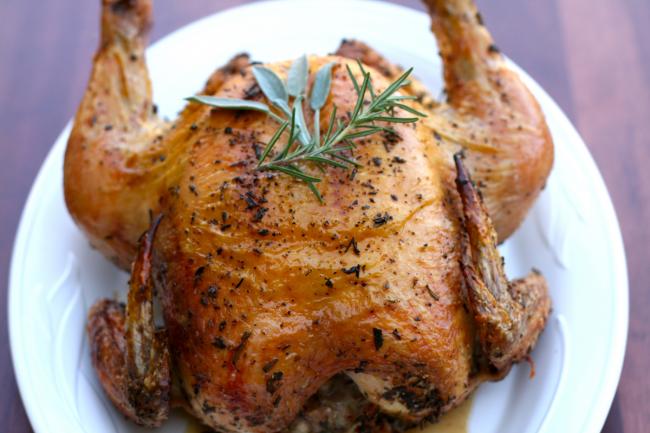You Are What You Eat: Got any thyme?
Roasted herb chicken.
Thu, 07/02/2015
By Katy Wilkens, MS, RD
My husband always forgets the name of this little herb, maybe because the leaves look so insignificant. Its leaves may be small, but thyme packs a big flavor punch. My garden is overflowing with this tenacious herb, which does great in rockeries, pots and tucked in your flowerbeds. If you don’t have thyme, look for it at farmers markets or in grocery stores. It’s worthwhile to get a 4-inch pot to grow thyme in your yard, as this tiny powerhouse will reward you all summer and well into fall. It will also come back next year. When it’s done flowering, cut the stems back about 1/3 of their length.
Thyme comes in many of varieties with more than 10 types just for cooking, which can all be substituted for each other. There are pretty, variegated types and golden ones, but any will do. Thyme is one of the three “fines herbes” used in French cooking. (The other two are parsley and bay leaf.) It is best to add thyme, and most fresh herbs, toward the end of cooking.
Use thyme in any egg dish. It also pairs well with tomato-based dishes and is a nice partner to tarragon and sage.
Thyme’s pungent, savory flavor is nicely set off by the use of lemon, which adds a sweet-sour edge.
Lemon-thyme dressing
½ cup salad oil
2 teaspoons grated lemon peel
¼ cup lemon juice
1 clove garlic, minced
1 ½ teaspoons sugar
1 teaspoon thyme leaves
Pepper to taste
1/3 cup parsley, chopped fine
If you are going to keep this dressing for more than a day, I suggest you lightly brown the garlic in a bit of olive oil, otherwise the flavor can get very strong. Combine oil, lemon peel, juice, garlic, sugar and thyme. Add pepper. Just before serving, stir in parsley. If made ahead of time, cover and refrigerate. Store for as long as one week. Makes 1 cup.
Nutritional information (per 2 tablespoons):
Calories: 126, Carbohydrates: 2 grams, Protein: 0 grams, Sodium: 1 milligrams
Roast herb chicken
1 whole chicken (4-5 pounds), fresh or thawed
2 tablespoons unsalted butter, softened
½ cup mixed fresh herbs: thyme, sage, tarragon, parsley
2 cloves garlic, peeled and crushed
1 lemon, thinly sliced
1 tablespoon olive oil
Heat oven to 450 degrees. Put chicken in a roasting pan. Put a small amount of water in the bottom of the pan to prevent burning. Mix together the butter, herbs and garlic in a small bowl. Place most of the herbed butter inside the body cavity of the chicken, along with the lemon slices. Slide the remaining herb butter between the skin and the breast meat by pulling back the skin slightly. Rub the olive oil over the skin of the bird. Roast for 15 minutes per pound, or until a meat thermometer reads 165 degrees for the internal temperature. Drain the buttery juices and slices of lemon and pour over chicken. Let chicken rest for 20 minutes before carving. Serves 4-6.
Nutritional information (serving):
Calories: 251, Carbohydrates: 0 grams, Protein: 19 grams, Dietary fiber: 18 grams, Fat: 0 grams, Sodium: 77 milligrams, Potassium: 222 milligrams, Phosphorus: 188 milligrams
The information in this column is meant for people who want to keep their kidneys healthy and blood pressure down by following a low-sodium diet. In most cases, except for dialysis patients, a diet high in potassium is thought to help lower high blood pressure. These recipes are not intended for people on dialysis without the supervision of a registered dietitian.
[Katy G. Wilkens is a registered dietitian and department head at Northwest Kidney Centers. The 2014 recipient of National Kidney Foundation Council on Renal Nutrition’s Susan Knapp Excellence in Education Award, she has a Master of Science degree in nutritional sciences from the University of Washington. See more of her recipes at www.nwkidney.org.]


